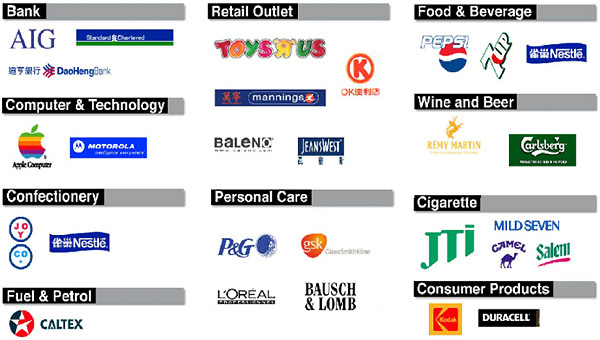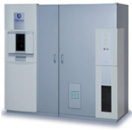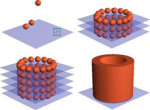BATTERY
To most people in the 21st century, batteries are simply a convenient substitute if mains electricity is impractical or unavailable. But when the battery was invented in 1800 it was the first device capable of providing an electric current.

Alessandro Volta (Italy) was an eminent physicist who made a number of significant breakthroughs in the field of electricity and is commemorated by the use of his name for the electrical unit of potential difference, the volt. His most famous invention, the battery, came about as the result of a disagreement with another Italian scientist, Luigi Galvani.
In 1775 Volta invented a 'perpetual electrophorus': an early form of electrical induction machine that could be used to generate and store static electricity. It worked by rubbing cat fur across a rubber-coated metal plate to build up a static charge, and then transferring the charge to a Leyden jar; by repeating the process several times a large charge could be built up. (The Leyden jar was invented in 1745 at the university of Leyden, Netherlands, as a means of storing electric charge.) Static electricity and the Leyden jar were nothing new, but what Volta had invented was a means of accumulating an electric charge.
Volta's real breakthrough, however, came when he heard about the electrical experiments of anatomist Galvani. Galvani had noticed that dissected frogs' legs would twitch if they were part of a circuit involving two metals, and concluded that the muscles and nerves were the source of what he called 'animal electricity'. Volta disagreed, thinking that the current was more likely to be due to the connection between the two metals; he began experimenting with pairs of metals and discovered that he could generate an electric current if certain metals were submerged in acid. The result, in 1800, was Volta's greatest invention, the 'voltaic pile'. It was the world's first battery - a series of copper and zinc strips submerged in salt water that could provide an electric current rather that mere status electricity. The following year, Napoleon I (ruler of Italy since its conquest by France in 1796) bestowed the Legion of Honour on Volta, in recognition of the importance of his invention, and made him a Count.

 Governments do not issue patents just for an idea.Ideas, thoughts or inspirations do not not qualify for a patent.
Governments do not issue patents just for an idea.Ideas, thoughts or inspirations do not not qualify for a patent.



 As our population ages, impaired vision caused by damaged retinas has increased.
As our population ages, impaired vision caused by damaged retinas has increased. Researchers at MIT have created the world's first batteries constructed from microscopic viruses.
Researchers at MIT have created the world's first batteries constructed from microscopic viruses. Elizabeth Redmond of Chicago is using the law of thermodynamics to create floor tiles that compress to generate and distribute electricity.
Elizabeth Redmond of Chicago is using the law of thermodynamics to create floor tiles that compress to generate and distribute electricity. Shoushan Fan, Kaili Jiang and Lin Xiao, scientists at Tsinghua University in Beijing, have invented a super-thin loudspeaker (one thousandth the width of a human hair).
Shoushan Fan, Kaili Jiang and Lin Xiao, scientists at Tsinghua University in Beijing, have invented a super-thin loudspeaker (one thousandth the width of a human hair). Anil Sethi, chief executive of the Swiss company Flison, holds a dark polymer foil. A paper-thin foil 200 times lighter than glass solar material. So light, it can be stuck to the sides of a building. So light, it can be mass-produced in rolls like packaging material.
Anil Sethi, chief executive of the Swiss company Flison, holds a dark polymer foil. A paper-thin foil 200 times lighter than glass solar material. So light, it can be stuck to the sides of a building. So light, it can be mass-produced in rolls like packaging material.
 This is one of those cool inventions that provides peace of mind for securing your information.
This is one of those cool inventions that provides peace of mind for securing your information. Most ciphers will use passwords that are four to eight characters in length, but a 128-bit AES cipher uses a 16 character password which is extremely difficult to hack.
Most ciphers will use passwords that are four to eight characters in length, but a 128-bit AES cipher uses a 16 character password which is extremely difficult to hack. Biometric authentication is a technology that recognizes physical or behavioral characteristics such as fingerprints, palm geometry, retina patterns, voice and signature. Fingerprint recognition is the most popular because it's easier to use.
Biometric authentication is a technology that recognizes physical or behavioral characteristics such as fingerprints, palm geometry, retina patterns, voice and signature. Fingerprint recognition is the most popular because it's easier to use. The Zoombak is one of those cool inventions utilizing gps technology.
The Zoombak is one of those cool inventions utilizing gps technology. This is one of those green inventions that captures energy.
This is one of those green inventions that captures energy. The tragic loss of lives from the lack of safe drinking water in the aftermath of the tsunami in Indonesia and the hurricane in Louisana, motivated inventor Micheal Pritchard to find a solution.
The tragic loss of lives from the lack of safe drinking water in the aftermath of the tsunami in Indonesia and the hurricane in Louisana, motivated inventor Micheal Pritchard to find a solution. Sawa Hiroshi is an engineer employed by the Oriental Development Company in Japan.
Sawa Hiroshi is an engineer employed by the Oriental Development Company in Japan. It takes about 30 minutes to make a roll and each one is made with the equivalent of 40 sheets of standard size office paper.
It takes about 30 minutes to make a roll and each one is made with the equivalent of 40 sheets of standard size office paper. The Powermat is a wireless charger for hi tech gadgets. You simply place your gadget on the mat to charge it.
The Powermat is a wireless charger for hi tech gadgets. You simply place your gadget on the mat to charge it. If you drink alcohol don't operate a vehicle. But the reality is that people rely on their own sense of sobriety if they have a glass of wine at a restaurant or a couple of beers during a sporting event.
If you drink alcohol don't operate a vehicle. But the reality is that people rely on their own sense of sobriety if they have a glass of wine at a restaurant or a couple of beers during a sporting event. If there is one thing that consumers have in common when it comes to their hi tech gadgets - it's their concern about cracked and scratched screens.
If there is one thing that consumers have in common when it comes to their hi tech gadgets - it's their concern about cracked and scratched screens. Oganovo is a company based in San Diego, California.
Oganovo is a company based in San Diego, California. A nanobot particle made from glass is being developed that can absorb pollutants from contaminated water.
A nanobot particle made from glass is being developed that can absorb pollutants from contaminated water. Physicist and inventor, Bruno Berge, has created a liquid optical lens.
Physicist and inventor, Bruno Berge, has created a liquid optical lens. Chungpin Liao, a professor at the Graduate School of Electro-Optic and Material Science of National Formosa University in Taiwan has invented an organic battery that creates electricity when wet.
Chungpin Liao, a professor at the Graduate School of Electro-Optic and Material Science of National Formosa University in Taiwan has invented an organic battery that creates electricity when wet.